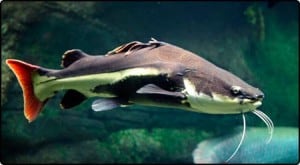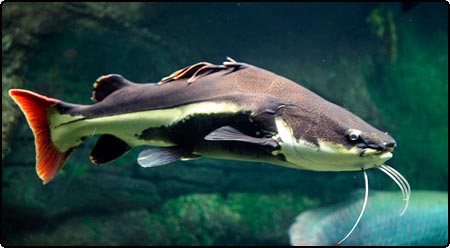
Common name: Redtail Catfish, pirarara
Scientific name: Phractocephalus hemioliopterus
Average Adult Fish Size: Varies depending on environment and food. The typical aquatic shop offer 3-4 inch fish which can easily grow to 24 inches or more within one year. In 2 years these fish can reach 30 inches or more in length. The biggest Redtail on record was 36 inches.
Place of Origin: Amazon River Basin, Brazil, Rio Negro, Venezuela
Typical Tank setup: Best to keep all heaters and filtration out of the aquarium due to large size. Look to use a sump or and external filter. Also I would recommend a minimalistic and robust décor.
Recommended Minimum Aquarium Capacity: 180 gallon / 680 litre – However due the size they grow look at getting a pond.
Compatibility: Due to being very predatory but not aggressive only keep with very large tank mates.
Temperature: 23 – 28 Deg C / 72 – 82 Deg F
Water chemistry: pH 6.0 to 7.0
Feeding: Not known as picky eaters, red-tail catfish love fish, worms, and crustaceans (which bring out their reds). They will also eat enough pellets to bloat their stomachs if given the opportunity. Large red-tails also eat rocks and can apparently spit them out at any given time (So watch out!)
Sexing: Unknown
Breeding: Unknown in captivity
Additional Information: Unfortunately, the prices of red-tails have fallen considerably in recent years and are readily available at very low prices. As a result many public aquaria have large displays of adult specimens that have been donated by fish keepers, often to the extent where they refuse to accept any more. A more depressing, but equally common scenario is that the fish are dumped into rivers and ponds when they outgrow their tank. In colder climates, they will obviously not survive, but populations exist in various states of the USA and several other countries as a result of releases by irresponsible aquarists.


Related Posts
Croaking Gourami – Trichopsis vittatus
Benthochromis Tricoti
Large-eyed Mouthbrooder – Callochromis Macrops